Jen-Yu Shieh , Zih-Yan Wang , Song-Yuh Huang , Song-Chi Huang , Jia-Long Zhang
Department of Electro-Optics Engineering, National Formosa University, Hue-Wei, Yue-Ling County 632, Taiwan
Correspondence to: Jen-Yu Shieh , Department of Electro-Optics Engineering, National Formosa University, Hue-Wei, Yue-Ling County 632, Taiwan.
| Email: |  |
Copyright © 2012 Scientific & Academic Publishing. All Rights Reserved.
Abstract
This paper follows International Standards Organization (ISO) by “Guide to the Expression of Uncertainty in Measurement, GUM”. In order to measure Ultraviolet Index (UVI) standard, it is necessary in calibration or test laboratory field norm on the authentication. By distance Inverse-Square Law of the Optical Radiation, We constructed measurement equation, to consider the error source when you are measuring, to evaluate the uncertainty of system. Evaluate the uncertainty of this system:The measurement distance is 75mm, ultraviolet index of the standard source is y = 11.7 UVI, effective degrees of freedom is Veff = 67, coverage factor is k = 2.0, confidence level is 95%, the standard uncertainty is uc= 0.13 UVI, expanded uncertainty is U= 0.3 UVI, the result is Y= y ± U= 11.7 ± 0.3 UVI.
Keywords:
Ultraviolet Index, Uncertainty, Calibration
Cite this paper:
Jen-Yu Shieh , Zih-Yan Wang , Song-Yuh Huang , Song-Chi Huang , Jia-Long Zhang , "Measure Uncertainty in Ultraviolet Index Standard", Electrical and Electronic Engineering, Vol. 2 No. 5, 2012, pp. 266-270. doi: 10.5923/j.eee.20120205.04.
1. Introduction
Measurement of light is an ancient science. Generally, it can be divided into optical radiation measurement [1],photometric measurement, and color measurement. Colorimetry[2] is clearly part of optical measurement related to color. Optical radiation and photometric measurements are measurements of optical parameters, and the main difference is that the latter includes the human visual response. The main purpose of this research is to construct a laboratory for testing standard. It refers to the spirit of ISO/IEC 17025 Standard, and follows “Guide to the Expression of Uncertainty in Measurement” (ISO GUM) made by ISO organization. The content includes UV test system construction, UVI transmittance measurement uncertainty, and the plan of measurement quality assurance that assures the stable operation of the laboratory system. Construct the equations of measurement uncertainty by the system methods that apply to the UVI transmittance measurement by UV spectroradiometer. The standard uncertainty is uc= 0.13 UVI, expanded uncertainty is U= 0.3 UVI, the result is Y= y ± U= 11.7 ± 0.3 UVI.
2. Objectives
2.1. Definition of Measurement Uncertainty
Measurement uncertainty is an estimate of the interval[3] used to represent the degree of dispersion of the measured values, so it is an evaluation of measurement quality. The more concentrated the measurement results are, the higher the measurement quality is, that is, the measurement uncertainty is smaller. On the contrary, the more dispersed the measurement results are, the lower the measurement quality is, and the measurement uncertainty is larger relatively.
2.2. Process to Measure Uncertainty
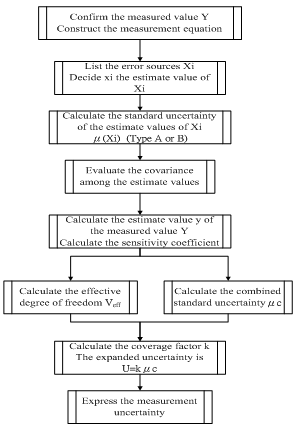 | Figure 1. Flow Chart of Process to Measure Uncertainty |
 | Figure 2. Calibration Based on the Light Source |
According to “Guide to the Expression of Uncertainty in Measurement, GUM”[4] published by International Standards Organization (ISO) in 2008, the eight steps of the process to measure uncertainty are illustrated in Fig. 1.[5]-[10]
3. Methods
3.1. Calibration Based on the Light Source
There are two methods for calibration; one is based on the light source, and the other is based on the instrument. The method based on the light source is shown in Fig. 2.[11]The intensity of the light source is I , and the illuminance[12] at r can be derived by inverse square law  . Then, compare the derived illuminance with that measured by the calibrated instrument. It can be calibrated with different illuminance values by changing the distance between the light source and the calibrated instrument. The following items should be considered in this method: 1) distance accuracy, 2) stability of the light source, 3) uniformity of the light source, 4) cosine correction of the instrument.
. Then, compare the derived illuminance with that measured by the calibrated instrument. It can be calibrated with different illuminance values by changing the distance between the light source and the calibrated instrument. The following items should be considered in this method: 1) distance accuracy, 2) stability of the light source, 3) uniformity of the light source, 4) cosine correction of the instrument.
3.2. Calibration Based on the Light Source
The other calibration method is based on the instrument. The instrument is calibrated by exchanging the position of the standard instrument with the calibrated one. The system structure is shown in Fig. 3. | Figure 3. Calibration Based on the Instrument |
First, adjust the distance between the standard instrument and the light source to measure the standard ultraviolet index  . Then, use the same distance to measure the ultraviolet index of the calibrated instrument
. Then, use the same distance to measure the ultraviolet index of the calibrated instrument  . The UVI instrument can be calibrated by comparing the standard value with the test one. The following items also need to be considered in the method based on the instrument: 1) consistency of the reference surface, 2) uniformity of the light source, 3) cosine correction of the instrument or the distance between the instrument and the light source. The data in this paper are measured by UVI instrument, but are calculated with the unit of irradiance
. The UVI instrument can be calibrated by comparing the standard value with the test one. The following items also need to be considered in the method based on the instrument: 1) consistency of the reference surface, 2) uniformity of the light source, 3) cosine correction of the instrument or the distance between the instrument and the light source. The data in this paper are measured by UVI instrument, but are calculated with the unit of irradiance  . The measured values should be transferred by 1UVI = 0.025
. The measured values should be transferred by 1UVI = 0.025  [13] before being calculated.
[13] before being calculated.
4. Results
4.1. Structure of Measurement System
According to the calibration methods mentioned in 3.2, the structure of the system in this thesis is shown in Fig. 4. | Figure 4. Structure of Measurement System |
4.2. Experiment Procedures
Measurement procedures of the experiment: Set up the equipments as Fig. 5.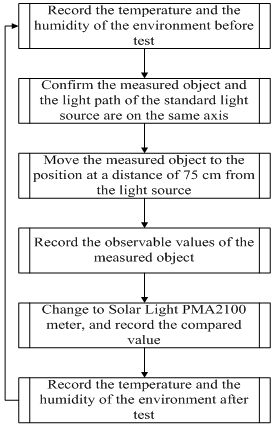 | Figure 5. Measurement Procedures of the Experiment |
Align the end surface of the instrument and the standard light source with the platforms respectively, and consider them as the starting and the end points for distance calculation.Procedures:Use TES-1367 thermo-hygrometer to record the humidity and temperature of the environment before measurement, and record them again after measurement.Check the level and the collimation of the instrument and the standard light source: Confirm if the emitting light of the light source and the instrument are at the same level, and if the light has a collimated incident. The method of confirmation: First, take the instrument to the position that the light source emits from, and observe if the detector of the instrument collimates with that position. If not, adjust the level of the supporting bar and the direction of the platform, shown as Fig. 6. Turn on the power of the instrument and the light source for 40 minutes before measurement[14][15]. When the system is steady, the measured values without the light source should be recorded.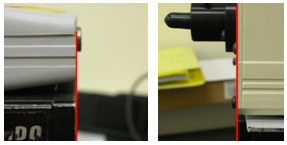 | Figure 6. Align the Instrument and the Standard Light Source with the Platform |
The displacement platform should be aligned with the slide scale to reduce the error. Every time after measurement, the light source should be changed to Solar Light PMA2100. Then, measure and record the data at the starting, middle and end point with erythemal spectral detector to ensure the stability of the standard light source.
4.3. Error Sources and Calculate Uncertainty
Actually, the error sources include the measurement methods, the equipments, the people, the environment, and the measured objects. Because of the time issue, only the measurement equipments and the environment are discussed in the thesis. Other factors are ignored. The error sources in our research are shown in Fig. 7. The four main impact factors are lamp current, UV radiation intensity, range, and meter reading.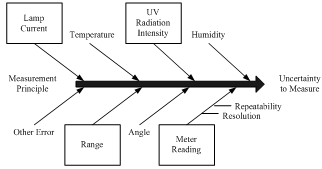 | Figure 7. Error Sources |
• Distance: Due to the inverse square law of irradiance, the error of distance is necessary to be considered. • Temperature and Humidity: Find the correlation coefficient r by the measured values of ultraviolet index, “Using (1).temperature ,and humidity. The correlation r between temperature and UVI is -0.228, and that between humidity and UVI is 0.215. The correlations are both below 0.3. Temperature and humidity are low correlation, and aren’t included in error factors. • The average temperature and humidity in thisexperiment are 26℃ and 64 %RH. • Angle: The angle is always set to zero about light source before measurement every time, so the error of angle is not considered. • Other Errors: Other errors are interferences of other light sources, the calibration differences ofthermo- hygrometer, thermal expansion coefficient of other measurement equipments, etc. These can be extended for advanced research direction. | (1) |
r: Correlation between any two input xi  The measurement equation of this research is shown below:
The measurement equation of this research is shown below: | (2) |
Which:I: Radiation Intensity Unit: Watt/Steradian (W/Sr)E: Irradiance Unit: Watt/meter 2 (W/m2)L: Measurement Distance Unit: meter (M)i: Lamp Current Unit: Ampere (A)Definitions:e: UVI Readinge1: Resolution of UVI instrumente2: Repeatability UVI instrument I: Radiation Intensity of Standard Lampi: Current of Standard LampL: DistanceThe measurement equation is represented by a function: | (3) |
Combined Standard Uncertainty: | (4) |
Each sensitivity coefficient  can be calculated below:
can be calculated below: | (5) |
Table 1. The Uncertainty Analysis of UVI Detector Calibration
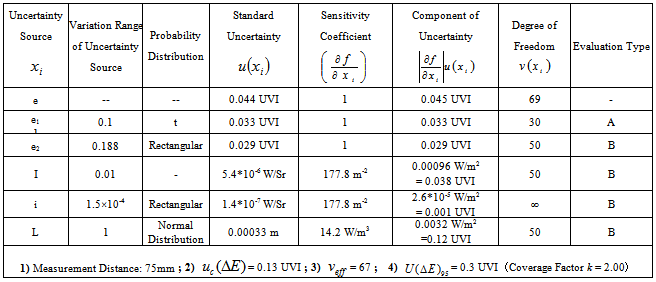 |
| |
|
 | (6) |
 | (7) |
 | (8) |
 : Effective Degree of Freedom
: Effective Degree of Freedom | (9) |
Calculation of each standard uncertainty: • UVI Reading (e): - Resolution (e1): The resolution of the instrument is: 0.1 UVI. It belongs to type B uncertainty evaluation. According to the references, the shape of the probability distribution is rectangular.The degree of freedom is
- Resolution (e1): The resolution of the instrument is: 0.1 UVI. It belongs to type B uncertainty evaluation. According to the references, the shape of the probability distribution is rectangular.The degree of freedom is  The standard uncertainty is Uc(e1):0.029(UVI)- Repeatability (e2):It belongs to type A uncertainty evaluation.The degree of freedom is
The standard uncertainty is Uc(e1):0.029(UVI)- Repeatability (e2):It belongs to type A uncertainty evaluation.The degree of freedom is  The standard uncertainty is Uc(e2):0.033(UVI)• Radiation Intensity of Standard Lamp (I):Radiation intensity of the light source is 0.00165 W/SrThe measurement distance is 75 mm => 0.075 MThe standard uncertainty is Uc(I):0.038(UVI)• Current of Standard Lamp Uc(i):0.001(UVI)• Distance (L): During measurement, the possible variation of L is less than±1mm. The data have more probability of appearing in the center of the interval than at both ends. The data of distances are estimated to form a normal distribution, and the degree offreedom→50.The standard uncertainty is Uc(L):0.12(UVI)Substitute each value into equation (2)~(9) respectively for calculation. The results of uncertainty analysis are shown in Table (1).The combined standard uncertainty is
The standard uncertainty is Uc(e2):0.033(UVI)• Radiation Intensity of Standard Lamp (I):Radiation intensity of the light source is 0.00165 W/SrThe measurement distance is 75 mm => 0.075 MThe standard uncertainty is Uc(I):0.038(UVI)• Current of Standard Lamp Uc(i):0.001(UVI)• Distance (L): During measurement, the possible variation of L is less than±1mm. The data have more probability of appearing in the center of the interval than at both ends. The data of distances are estimated to form a normal distribution, and the degree offreedom→50.The standard uncertainty is Uc(L):0.12(UVI)Substitute each value into equation (2)~(9) respectively for calculation. The results of uncertainty analysis are shown in Table (1).The combined standard uncertainty is .The effective degree of freedom is
.The effective degree of freedom is . The expanded uncertainty: Set the confidence level 95%. By searching from the table, the coverage factor is k=2.0,
. The expanded uncertainty: Set the confidence level 95%. By searching from the table, the coverage factor is k=2.0, .
.
5. Discussion and Conclusions
This paper refers to “Guide to the Expression of Uncertainty in Measurement” of ISO GUM to complete the uncertainty evaluation of UVI measurement. It is expected to get the ISO 17025 certification from international laboratory. It is calibrated by the UVI instrument and the UVB biologic lamp sold in the market. The error values can be known, and the reliability of the product is got by the users. Besides, the standard light source used in this thesis hasn’t been calibrated by the advanced laboratory. If the light source is calibrated in the future, this paper will become more credible. Finally, in our laboratory we built this measurement distance is 75mm, ultraviolet index of the standard source is y = 11.7 UVI, effective degrees of freedom is Veff = 67, coverage factor is k = 2.0, confidence level is 95%, the standard uncertainty is uc= 0.13 UVI, expanded uncertainty is U= 0.3 UVI, the result is Y= y ± U= 11.7 ± 0.3 UVI.
References
| [1] | Yueh-Sung Chiang, Yu-Min Sung, Cheng-Yu Liu,Chung-Hsing Chuan, Chi-Te Chen, Opto-Electronic Technology, Wun Ching Publishing Group, 1-7, 2005. |
| [2] | Yu-Ying An, Hsiao-Tung Tseng, “Optical Sensors and Light Measurement”, Publishing House of Electronics Industry, 41-46, 2001. |
| [3] | Lai-Fa Hung, Statistics, Wun Ching Publishing Group, 189-214. |
| [4] | Evaluation of measurement data — Guide to the expression of uncertainty in measurement-2008. |
| [5] | Hung-Chi Yang, Research of Calibration and Evaluation Mode in Secondary Laboratory, Center for Measurement Standards of Industrial Technology Research Institute, Measurement Information Vol. 73, 25-34, 2000. |
| [6] | JCGM 100:2008 Evaluation of Measurement Data — Guide to the Expression of Uncertainty in Measurement, page 4-27. |
| [7] | JCGM 101:2008 Evaluation of Measurement Data — Supplement 1 to the Guide to the Expression of Uncertainty in Measurement — Propagation of Distributions Using a Monte Carlo Method, page 7-27. |
| [8] | Taiwan Accreditation Foundation, Measurement Uncertainty Assessment Guidelines in the Correction Field, TAF-CNLA-G16(1), page 9-31. |
| [9] | ISO GUM Measurement Uncertainty and Statistics Application Workshop (Basic Class), Center for Measurement Standards of Industrial Technology Research Institute, 0797-CM011, 2008. |
| [10] | China National Accreditation Service for ConformityAssessment, Guidance on the Application of the. Requirements for Measurement Uncertainty, CNAS-CL05:2006. |
| [11] | Ying-Hui Chen, “Basic Photometry and Measurement Practices”, Center for Measurement Standards of Industrial Technology Research Institute, Measurement Information Vol. 106, 11-16, 2005. |
| [12] | NIST Measurement Services SP250-37 Photometric Calibration p1~9. |
| [13] | CIE Standard CIE S 013/E:2003 International Standard Global Solar UV Index p1~3. |
| [14] | CIE Standard 009/E:2002 Photo biological Safety of Lamps and Lamp System p17~19. |
| [15] | Newport Model 1918-C Hand-held Optical Meter Startup Guide. |



 . Then, compare the derived illuminance with that measured by the calibrated instrument. It can be calibrated with different illuminance values by changing the distance between the light source and the calibrated instrument. The following items should be considered in this method: 1) distance accuracy, 2) stability of the light source, 3) uniformity of the light source, 4) cosine correction of the instrument.
. Then, compare the derived illuminance with that measured by the calibrated instrument. It can be calibrated with different illuminance values by changing the distance between the light source and the calibrated instrument. The following items should be considered in this method: 1) distance accuracy, 2) stability of the light source, 3) uniformity of the light source, 4) cosine correction of the instrument.
 . Then, use the same distance to measure the ultraviolet index of the calibrated instrument
. Then, use the same distance to measure the ultraviolet index of the calibrated instrument  . The UVI instrument can be calibrated by comparing the standard value with the test one. The following items also need to be considered in the method based on the instrument: 1) consistency of the reference surface, 2) uniformity of the light source, 3) cosine correction of the instrument or the distance between the instrument and the light source. The data in this paper are measured by UVI instrument, but are calculated with the unit of irradiance
. The UVI instrument can be calibrated by comparing the standard value with the test one. The following items also need to be considered in the method based on the instrument: 1) consistency of the reference surface, 2) uniformity of the light source, 3) cosine correction of the instrument or the distance between the instrument and the light source. The data in this paper are measured by UVI instrument, but are calculated with the unit of irradiance  . The measured values should be transferred by 1UVI = 0.025
. The measured values should be transferred by 1UVI = 0.025  [13] before being calculated.
[13] before being calculated.




 The measurement equation of this research is shown below:
The measurement equation of this research is shown below:


 can be calculated below:
can be calculated below:



 : Effective Degree of Freedom
: Effective Degree of Freedom
 - Resolution (e1): The resolution of the instrument is: 0.1 UVI. It belongs to type B uncertainty evaluation. According to the references, the shape of the probability distribution is rectangular.The degree of freedom is
- Resolution (e1): The resolution of the instrument is: 0.1 UVI. It belongs to type B uncertainty evaluation. According to the references, the shape of the probability distribution is rectangular.The degree of freedom is  The standard uncertainty is Uc(e1):0.029(UVI)- Repeatability (e2):It belongs to type A uncertainty evaluation.The degree of freedom is
The standard uncertainty is Uc(e1):0.029(UVI)- Repeatability (e2):It belongs to type A uncertainty evaluation.The degree of freedom is  The standard uncertainty is Uc(e2):0.033(UVI)• Radiation Intensity of Standard Lamp (I):Radiation intensity of the light source is 0.00165 W/SrThe measurement distance is 75 mm => 0.075 MThe standard uncertainty is Uc(I):0.038(UVI)• Current of Standard Lamp Uc(i):0.001(UVI)• Distance (L): During measurement, the possible variation of L is less than±1mm. The data have more probability of appearing in the center of the interval than at both ends. The data of distances are estimated to form a normal distribution, and the degree offreedom→50.The standard uncertainty is Uc(L):0.12(UVI)Substitute each value into equation (2)~(9) respectively for calculation. The results of uncertainty analysis are shown in Table (1).The combined standard uncertainty is
The standard uncertainty is Uc(e2):0.033(UVI)• Radiation Intensity of Standard Lamp (I):Radiation intensity of the light source is 0.00165 W/SrThe measurement distance is 75 mm => 0.075 MThe standard uncertainty is Uc(I):0.038(UVI)• Current of Standard Lamp Uc(i):0.001(UVI)• Distance (L): During measurement, the possible variation of L is less than±1mm. The data have more probability of appearing in the center of the interval than at both ends. The data of distances are estimated to form a normal distribution, and the degree offreedom→50.The standard uncertainty is Uc(L):0.12(UVI)Substitute each value into equation (2)~(9) respectively for calculation. The results of uncertainty analysis are shown in Table (1).The combined standard uncertainty is .The effective degree of freedom is
.The effective degree of freedom is . The expanded uncertainty: Set the confidence level 95%. By searching from the table, the coverage factor is k=2.0,
. The expanded uncertainty: Set the confidence level 95%. By searching from the table, the coverage factor is k=2.0, .
. Abstract
Abstract Reference
Reference Full-Text PDF
Full-Text PDF Full-Text HTML
Full-Text HTML